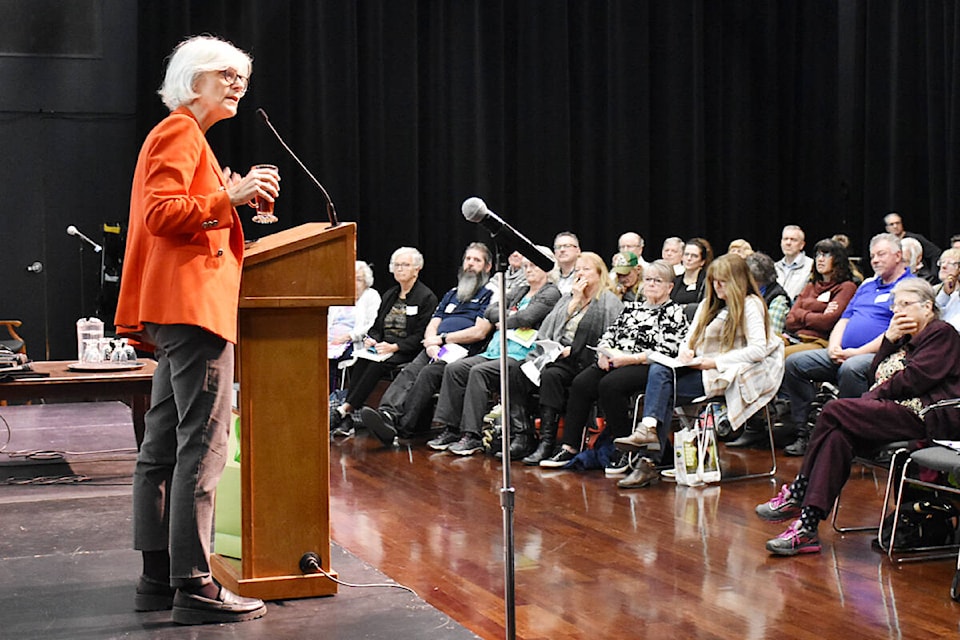Seniors in B.C. are better off going into a long-term care facility than to receive support at home, a big source of frustration for the outgoing BC Seniors Advocate, who outlined her thoughts at the Seniors Affordable Housing Forum in Maple Ridge on Wednesday, March 6.
Isobel Mackenzie, who has more than two decades of experience working with seniors in addition to serving on a number of national and provincial boards and commissions before being appointed Seniors Advocate for B.C., was in town for the forum and shared her thoughts about government supports available for seniors as they age.
However, Mackenzie made clear how exasperated and disappointed she is with how few seniors receive the help they need in the province.
What seniors need, is to live in a place that is accessible – a place that has no stairs, a bathroom that is square so a walker can easily turn, and a shower as opposed to a bath tub. Seniors also need a place that is located centrally so the can walk to places when they are no longer able to drive.
If they have that, Mackenzie said there is no amount of care the government can’t provide in a home.
However, it is care that comes at a high cost.
A key element to people staying in their own home is access to services and supports, said Mackenzie.
A senior can have a perfectly accessible home, but they need help having a bath, or somebody to get them up in the morning and make sure their medications are taken.
But, Mackenzie noted, a large percentage of seniors in the province cannot afford government supports for these daily living activities.
“And we charge you a lot,” said Mackenzie, of services which are offered for free in both Alberta and Ontario.
Mackenzie gave an example of a senior who requires one hour a day for help in the house and one extra hour for bath assist.
If this person’s income is $29,000 a year, just more than the cutoff income to qualify for the Guaranteed Income Supplement, GIS, a federal program which provides a monthly payment for low income seniors 65 and older, they would have to pay $9,000 a year for the service with the government chipping in $5,000.
For a senior who receives the GIS, the daily rate is waived by the government for this service.
READ MORE: Seniors ‘disheartened’ with B.C. budget: retired persons’ association
However, only 30 per cent of seniors in B.C. qualify for the GIS – so 70 per cent are charged.
And it does not matter if this person is renting their place or they own a $1.5 million property – both are treated the same, said Mackenzie.
In comparison, a person who didn’t get the help they needed, and fell and broke their hip, would now require long term care. Long term care beds cost about $82,000 a year, which the senior would pay $22,000 of the cost and the government would pay $65,000. But, for the $22,000, the senior would get three meals a day, all their medications covered, equipment, incontinence supplies, and more.
This means that more seniors are turning to long term care – even when they don’t require it – because financially it makes more sense.
Mackenzie pointed out there is also assisted living, which might cost between $3,500 to $4,000 a month, but that, she said, comes with no care – just the housing, two meals a day, and weekly cleaning. For somebody who does not have high medication costs it might make sense, but for others it is also unaffordable.
ALSO: ‘Fierce advocate’ set to retire as the voice for B.C. seniors after 9 years on the job
B.C. has twice as many low-care needs people in long-term care as they do in Alberta and Ontario, and 61 per cent of new admissions to long-term care in the province had no home supports prior to admission.
“There’s not a big difference between the clinical needs of someone whose income is $23,000 and someone whose income is $28,000. The difference is one of them has GIS, one of them doesn’t. One of them gets home support for free, the other has to pay $9,000 a year. I am clearly frustrated by this,” said the outgoing senior’s advocate.
“I had hoped it would be addressed in the budget. It was not,” she said. “And it is one of the significant barriers to living at home.”
What happens, said Mackenzie, is people who have the money can live at home, but the people who don’t, can’t.
